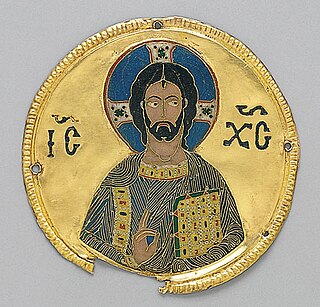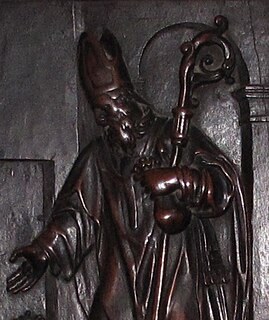This article needs additional citations for verification .(March 2014) |
St. Nicodemus of Palermo (died 1083) was a Sicilian Eastern Orthodox bishop.
This article needs additional citations for verification .(March 2014) |
St. Nicodemus of Palermo (died 1083) was a Sicilian Eastern Orthodox bishop.
The early Orthodox church of Sicily was Byzantine and part of the Patriarchate of Constantinople. Under Muslim rule, from around 827 until the 1060s, Christians in Sicily, like Jews, became a subjugated people, mildly persecuted and highly taxed but allowed, in most cases, to practice their religion and professions. [1] In Palermo alone there were twenty Orthodox Churches. [2]
In 1072, he celebrated the entry of Roger I of Sicily to Palermo and the end of the Muslim rule over the city. The old Church of Saint Mary, which had been turned into a mosque some two hundred and forty years earlier, was reconsecrated and Nicodemus celebrated a Te Deum service there. [1] The new rulers, after establishing their position, sent him to live outside the city in the area now called Mezzomonreale. Because of his fidelity to the Eastern Orthodox Church, he was sent from Palermo. The new political power installed a bishop loyal to Rome in the city.
Nicodemus died in 1083. His body is buried in a stone sarcophagus in the crypt of the Norman era Palermo Cathedral. [2]
Established on 5 May 2002, the Cross of Merit of Saint Nicodemus, Orthodox Bishop of Palermo, was instituted by his successor Lorenzo, Metropolitan of the Ukrainian Autocephalous Orthodox Church - Abroad and Archbishop of Palermo and All Italy, as an award of merit for those who serve the Church in Palermo or who are benefactors of that Church. [2]
It is awarded as a meritorious cross by the Confraternity of the Knights of the Most Holy Trinity, of which Archbishop Lorenzo is Grand Master. [3]

The Eastern Orthodox Church, also called the Orthodox Church, is the second-largest Christian church, with approximately 220 million baptized members. It operates as a communion of autocephalous congregations, each governed by its bishops and adherents in local synods. The church has no central doctrinal or governmental authority analogous to the Head of the Roman Catholic Church, the Pope, but the Ecumenical Patriarch of Constantinople is recognized by them as primus inter pares and regarded as the spiritual leader of many of the eastern Christian parishes. As one of the oldest surviving religious institutions in the world, the Eastern Orthodox Church has played a prominent role in the history and culture of Eastern and Southeastern Europe, the Caucasus, and the Near East. The Eastern Orthodox Church officially calls itself the Orthodox Catholic Church.

Palermo is a city in southern Italy, the capital of both the autonomous region of Sicily and the Metropolitan City of Palermo, the city's surrounding metropolitan province. The city is noted for its history, culture, architecture and gastronomy, playing an important role throughout much of its existence; it is over 2,700 years old. Palermo is in the northwest of the island of Sicily, by the Gulf of Palermo in the Tyrrhenian Sea.

Bartholomew I is the 270th and current archbishop of Constantinople and Ecumenical Patriarch, since 2 November 1991. In accordance with his title, he is regarded as the primus inter pares in the Eastern Orthodox Church, and as the spiritual leader of the Eastern Orthodox Christians worldwide.

Roger I, nicknamed Roger Bosso and The Great, was a Norman nobleman who became the first Count of Sicily from 1071 to 1101. He was a member of the House of Hauteville, and his descendants in the male line continued to rule Sicily down to 1194.

An exarch was the holder of any of various historical offices, some of them being political or military and others being ecclesiastical.

July 13 - Eastern Orthodox Church calendar - July 15

Olivia of Palermo, Palermo, 448 – Tunis, 10 June 463, while according to another tradition she is supposed to have lived in the late 9th century AD during the muslim emirate of Sicily is a Christian virgin-martyr who was venerated as a local patron saint of Palermo, Sicily in the Middle Ages, as well as in the Sicilian towns of Monte San Giuliano, Termini Imerese, Alcamo, Pettineo and Cefalù.

The Emirate of Sicily was an Islamic kingdom that ruled the island of Sicily from 831 to 1091. Its capital was Palermo, which during this period became a major cultural and political center of the Muslim world.
Nicodemus was a Pharisee who showed favor to Jesus. The name derives from Greek and it means victory of the people. Nicodemus may refer to one of the following:

The Roman Catholic Metropolitan Archdiocese of Palermo was founded as the Diocese of Palermo in the first century and raised to the status of archdiocese in the 11th century. The archbishop is Corrado Lorefice.

Pancras or Pancratius is an Italian saint associated with Taormina and venerated as a Christian martyr. His surviving hagiography is purely legendary. He is, however, recorded in some early martyrologies.
Eastern Orthodoxy in North America represents adherents, religious communities, institutions and organizations of Eastern Orthodox Christianity in North America, including the United States, Canada, Mexico and other North American states. Estimates of the number of Eastern Orthodox adherents in North America vary considerably depending on methodology and generally fall in range from 3 million to 6 million. Most Eastern Orthodox Christians in North America are Russian Americans, Turkish Americans, Greek Americans, Arab Americans, Ukrainian Americans, Albanian Americans, Macedonian Americans, Romanian Americans, Bulgarian Americans and Serbian Americans, with Americans from other Eastern European countries and growing minorities of converted Americans of Western European, African, Latin American, and East Asian descent.
The timeline of Eastern Orthodoxy in North America represents timeline of the historical development of religious communities, institutions and organizations of Eastern Orthodox Christianity in North America.

The Eparchy of Piana degli Albanesi is a eparchy (diocese) of the Italo-Albanian Catholic Church, Eastern Catholic sui iuris of Byzantine Rite, covering the island of Sicily in Italy.

In 9th-century Christianity, Charlemagne was crowned as Holy Roman Emperor, which continued the Photian schism.

Christianity in the 11th century is marked primarily by the Great Schism of the Church, which formally divided the State church of the Roman Empire into Eastern (Greek) and Western (Latin) branches.

The Italo-Albanian Catholic Church, Italo-Albanian Byzantine-Catholic Church or Italo-Albanian Church, is one of the 23 Eastern Catholic Churches which, together with the Latin Church, compose the Catholic Church. It is a particular church that is autonomous (sui juris), using the Byzantine Rite. The liturgical languages used therein are Koine Greek and Albanian. The Italo-Albanian (Arbëreshë) members are concentrated in Southern Italy and Sicily; in central Italy they are present only in the territorial Abbey in the Lazio region.

Theodorus I was Archbishop of Milan from 475 to 490. He is honoured as a saint in the Eastern Orthodox Church and Catholic Church, and his feast day is July 27.

December 5 - Eastern Orthodox liturgical calendar - December 7
This is a timeline of the presence of Eastern Orthodoxy in Greece from 717 to 1204. The history of Greece traditionally encompasses the study of the Greek people, the areas they ruled historically, as well as the territory now composing the modern state of Greece.